
The Pilling connection.
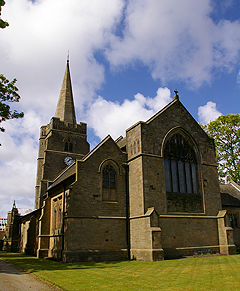 We
know the area has been inhabited since the Neolithic times. Finds of stone age flint & stone
axes, bronze spears & Saxon beads have been found all around Pilling. It is
certain the Romans passed the area. Maybe there were Druids on Eagland hill? In
this area of Lancashire called Amounderness (it is said it's place names,
especially north of the lower
Fylde, are of Viking origins). Amounderness itself may be Norse, possibly
translated as; Agmundr
being a chieftain, it means Agmundr's promontory. Those
who know better than me (educated folk!) discuss & argue about how place names
derive. Our roots are in Eagland Hill, which they claim derives from the
Norse Eiki Lundr, meaning oak grove. (a Lund was a sacred grove where
pagan rites were carried out). I don't think I could have guessed that ever!
We
know the area has been inhabited since the Neolithic times. Finds of stone age flint & stone
axes, bronze spears & Saxon beads have been found all around Pilling. It is
certain the Romans passed the area. Maybe there were Druids on Eagland hill? In
this area of Lancashire called Amounderness (it is said it's place names,
especially north of the lower
Fylde, are of Viking origins). Amounderness itself may be Norse, possibly
translated as; Agmundr
being a chieftain, it means Agmundr's promontory. Those
who know better than me (educated folk!) discuss & argue about how place names
derive. Our roots are in Eagland Hill, which they claim derives from the
Norse Eiki Lundr, meaning oak grove. (a Lund was a sacred grove where
pagan rites were carried out). I don't think I could have guessed that ever!
Just trying to find where the word Pilling comes from is unclear to me.
One says "from a diminutive of the Olde British word pyl meaning a pool". (Would you believe anyone who put an "e" on Old?).
The other says "English (Lancashire): topographic name from Old English piling ‘dweller by the stake’ or pylling ‘dweller by the stream’".
Yet another claims "Pilling is derived from Celtic Pyll meaning a creek & ing a diminutive".
I guess the common factor is
water!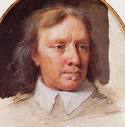
My wife's branch of the family tree have their roots deep in the Pilling area. The earliest we know of was Ralph Hoole, who was born just before the plague was registered in the Pilling area in 1610 & obviously survived ten years before the end of the 1650 plague that raged in Pilling & the Fylde area, the last mention of the plague in Pilling being in 1652. He had the courage to marry in 1640 & had five children (we only know Jane definitely survived). We are as far back as the second year of Oliver Cromwell as Lord Protector. The death toll was horrific as recorded by the curate, the Rev. John Lumley of St Johns. The register of burials did not begin in Pilling until 1685 so there is no definite numbers known but in a petition for poor relief, Rev. Lumley noted there were 300 families "not able to subsist". Of course the Plague must have been blamed on everything back then. Earthquakes, comets, gluttony or God's wrath. We are in a period of only 40 years after the Lancashire witches were hung a few miles away in Lancaster. Folks believed in Bogart's & Jenny Greenteeth, who pulled children into deep pools. People must have been desperate for cures as it swept the entire country. Figures from near Pilling list hundreds of deaths from 1614 onwards. We know now, it was the fleas from the black rat. What I didn't realise was, there were two kinds of plague, "Bubonic" & "Pneumonic". The bubonic was more common & a mortality rate of 60% where it took about a week to died, whereas the pneumonic was almost 100% fatal & death was much quicker.
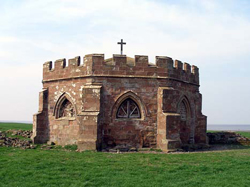 So far as we can gather, Pilling
was bound to the monks of Cockersand Abbey. It was an isolated, boggy marsh area cut off from
the rest of England & inhabited by people who were self sufficient, hardy &
mainly farmers .. the hard way. In his book "A history of Pilling",
F.J.Sobee (a village schoolmaster of Pilling) commented "Pilling must have been
just a few huts in the 27000 acres of waste, moss & marsh, with a
small coastal strip. Communication, apart from one or two tracks, across the
bog, with the outside world, would be difficult. Indeed until 1780, the only
road was from Cockerham, along the shore and on to Pilling Lane".
So far as we can gather, Pilling
was bound to the monks of Cockersand Abbey. It was an isolated, boggy marsh area cut off from
the rest of England & inhabited by people who were self sufficient, hardy &
mainly farmers .. the hard way. In his book "A history of Pilling",
F.J.Sobee (a village schoolmaster of Pilling) commented "Pilling must have been
just a few huts in the 27000 acres of waste, moss & marsh, with a
small coastal strip. Communication, apart from one or two tracks, across the
bog, with the outside world, would be difficult. Indeed until 1780, the only
road was from Cockerham, along the shore and on to Pilling Lane".
Two family names, from Pilling, that married & created our known family
line were Richard Dicconson, (probably related to a Richard Dicconson, a yeoman
who lived at Preesall in 1627) & an Alice Fish or Till (the Pilling
records & the Mormon records do not agree on her name), he was born two year
before 1720, the year of one of Pilling
great floods. It arose on Sunday & Monday of the 18th & 19th of December. In a petition for help
signed by 11 members of the Pilling community, the
winds were described as "a dreadful tempest". It overflowed 1500 acres of land
destroying most of the wheat & rye that had been sown, together with 40 houses.
According to the diary of a William Stout, 8 lives were lost in Thornham Moss &
"it remained like a sea for four days" & in Pilling, Meols & Marton
Mere 10 people drown. Other recorded high
tides & flooding were in 1883, 1907 & 1927.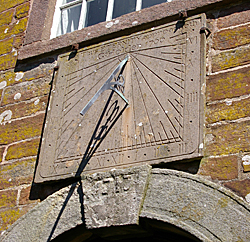
Homes were built of peat or clay and heather mixed in. Some used cobblestones & a few were crux built (leaning two tree trucks together & putting the ridge pole between the two ends). The sides were built up with branches & covered in clay. The floors were made of clay & usually covered by rushes. (they were using rushes to cover the floor of the old chapel around 1822, at the cost of 10/- or 50p in today's money). These were the days of candles, peat for fires, lamps & wells. The Rev J.D. Bannister said of Eagland Hill in 1869, "This extensive tract of bog-land, which had been at the start of the century, not merely unprofitable, but in reality a poison bog, diffusing miasma, ague and low fever among the surrounding population". Miasma means: Noxious exhalations from putrescent organic matter; poisonous effluvia or germs polluting the atmosphere. & the meaning of Ague is: a malarial fever characterized by regularly returning paroxysms, marked by successive cold, hot, and sweating fits. It takes a brave family that will risk everything to conquer such a place. It is amazing to realise that it wasn't until 1931 that piped water was brought to the village, electricity didn't come in until 1936.
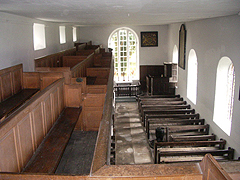 All
our kin were baptised, married & were buried in St. John the Baptist church. The
original building is said to have its origins in Saxon times. It was located
near a place called Newers Wood by Stake Pool. On a map of 1577 it is shown a
little distance from Pilling Hall. There is very little left of it, as it's stones were use in the next chapel to be
built & there are a few in Pilling Hall Farm. There remains just one grave stone
to Richard, son of Christopher Clark who was buried 10th of February 1720,
surely one of the last souls to rest in the original grounds.
All
our kin were baptised, married & were buried in St. John the Baptist church. The
original building is said to have its origins in Saxon times. It was located
near a place called Newers Wood by Stake Pool. On a map of 1577 it is shown a
little distance from Pilling Hall. There is very little left of it, as it's stones were use in the next chapel to be
built & there are a few in Pilling Hall Farm. There remains just one grave stone
to Richard, son of Christopher Clark who was buried 10th of February 1720,
surely one of the last souls to rest in the original grounds.
As the area grew, a new & bigger chapel was definitely needed. On the next chapel, above the door (now called the old chapel by Pillingers), it's keystone bears the year of 1717. It was consecrated in 1721 & it is one of the finest examples of a Georgian church in existence. This is the reign of King George II, Robert Walpole becoming Great Britain's first Prime Minister & the end of the "Golden" period of Antonio Stradivari's violins.
In 1774 Richard & Alice's daughter Elizabeth Dicconson married William Gornall, their children producing my wife's direct line. The "mad" King George the third was on the throne & it was a year after the Boston Tea Party happened in the Americas.
In 1848 the Gornall clan married into the Jenkinson family. Both families came
together on Eagland Hill due to the magnificent efforts of Eagland Hill pioneers, James
Jenkinson (known as Old Jemmy) & Joseph Hoyles. They were the people who helped
drained Pilling Moss & brought their families up by shear hard work, grit &
determination.
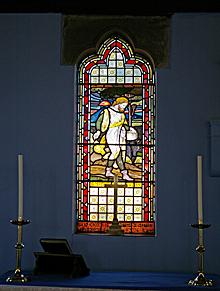
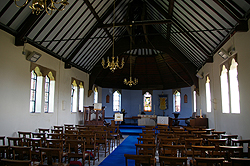 Old Jemmy had married in Churchtown near Garstang in 1808.
He
walked all the way from Churchtown, near Garstang, every night after he had
finished work, and built his cottage from clay, which he carried a basket-load
at a time from the nearest source. Even as the crow flies that's over three
miles & its doubtful they were anything more that tracks then.
Joseph Gornall, at 15, had moved to Eagland
Hill, where he was was working as a live-in man servant for farmer Joseph Isles
(or Hoyles) It was here he met Mary, daughter of Old Jemmy & he too continued to
farm Eagland Hill.
Old Jemmy had married in Churchtown near Garstang in 1808.
He
walked all the way from Churchtown, near Garstang, every night after he had
finished work, and built his cottage from clay, which he carried a basket-load
at a time from the nearest source. Even as the crow flies that's over three
miles & its doubtful they were anything more that tracks then.
Joseph Gornall, at 15, had moved to Eagland
Hill, where he was was working as a live-in man servant for farmer Joseph Isles
(or Hoyles) It was here he met Mary, daughter of Old Jemmy & he too continued to
farm Eagland Hill.It is recorded that on August 20th 1835 the shock of an 4.4 earthquake was felt in Lancaster, Kendal, Garstang, Pilling, Poulton, Kirkham and Carleton. Joseph would have been 12 at the time & Old Jemmy just short of 50. I imagine the whole of Pilling would have remembered that for the rest of their lives.
Very soon the people of Pilling were filling the old chapel until it couldn't cope. In 1813, permission was given to take off the roof & build up the walls to put in an upper gallery. Despite this, Pilling was either growing at a huge rate or they were all God fearing folk & by 1861 it was agreed that the children should be kept in the school during the morning service to allow more room for the adults, plus the burial ground was so full they needed to extend that too. according to Gazetteer and Directory of England, Pilling population in 1861 was 1,388. The number of houses was 234. It said, "Much of the land is peat moss; and large quantities of turf are cut".
It was so overcrowded that by 1887 they thought a new church had to be built. The last service in the old chapel attracted upwards of 400 people, the children being sent home to make room for the adults.
While this was going on, Eagland Hill needed its own church too. The
Rev. J.D. Bannister was responsible for erecting St Marks's mission church. The
foundation stone was laid by Old Jemmy on 13th August 1869, the alter now
standing where the fireplace was in Old Jemmy's original cottage. After seeing
a dream come true, Old Jemmy died
in the November of 1874.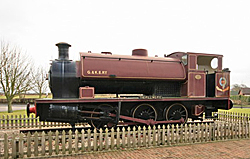
 It was around 1870 that things must have been changed for the farmers of
Pilling.
A single track line was built over the seven and a half miles to Garstang by the
Pilling Railway Co. It began operations, mainly to support the local
agricultural industry. From an exchange siding in the goods yard of the LNWR
Garstang & Catterall station the line passed through Garstang itself then Nateby
and three small stations to the terminus at Pilling.
There is some dispute about how it got it's name. One theory is the noise made by the
engine on the curves was likened to the squealing
of a pig and the other is the sound of its whistle.
Which ever is true, all the trains on the
line were thereafter known as 'the Pilling Pig' by the locals. The
line was operated (officially) on a one-engine-in-steam basis until 1908 and had
no signals until the extension was built. The signals then installed were timber
slotted post types. Goods yards at Garstang, Pilling and Knott End were usually
well filled with farmers carts, it was not unusual for odd wagons to be dropped
off along the line for loading with produce. As Birks Farm on Eagland Hill was
about a mile & a half away, no doubt they took advantage of this facility. On the return journey these wagons
were simply pushed ahead of the engine to the next goods yard. In 1872, after well over a year of almost
continuous use, the locomotive broke down. This caused a suspension of service,
which in turn led to the company being in rent arrears. The locomotive was
repossessed, and for the next three years only occasional horse-drawn trains
were run. Goods services
resumed in February 1875 using
a new engine, Union.
Passenger services followed the April. A replacement engine, Farmer's
Friend, was acquired in December of that year.
It was around 1870 that things must have been changed for the farmers of
Pilling.
A single track line was built over the seven and a half miles to Garstang by the
Pilling Railway Co. It began operations, mainly to support the local
agricultural industry. From an exchange siding in the goods yard of the LNWR
Garstang & Catterall station the line passed through Garstang itself then Nateby
and three small stations to the terminus at Pilling.
There is some dispute about how it got it's name. One theory is the noise made by the
engine on the curves was likened to the squealing
of a pig and the other is the sound of its whistle.
Which ever is true, all the trains on the
line were thereafter known as 'the Pilling Pig' by the locals. The
line was operated (officially) on a one-engine-in-steam basis until 1908 and had
no signals until the extension was built. The signals then installed were timber
slotted post types. Goods yards at Garstang, Pilling and Knott End were usually
well filled with farmers carts, it was not unusual for odd wagons to be dropped
off along the line for loading with produce. As Birks Farm on Eagland Hill was
about a mile & a half away, no doubt they took advantage of this facility. On the return journey these wagons
were simply pushed ahead of the engine to the next goods yard. In 1872, after well over a year of almost
continuous use, the locomotive broke down. This caused a suspension of service,
which in turn led to the company being in rent arrears. The locomotive was
repossessed, and for the next three years only occasional horse-drawn trains
were run. Goods services
resumed in February 1875 using
a new engine, Union.
Passenger services followed the April. A replacement engine, Farmer's
Friend, was acquired in December of that year.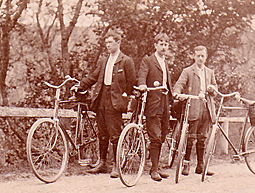
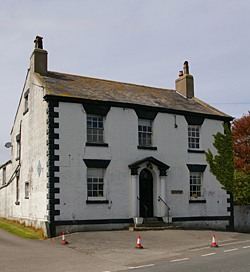 The Gornall's also married other Pilling names like the Morley's & Ronsons who were all in
farming & the Danson
family, William (born 1763) & his
son Joseph born in (1812) who were the town blacksmiths. I would have thought it easy to find a picture of the
village blacksmiths ... but nothing so far!
The Gornall's also married other Pilling names like the Morley's & Ronsons who were all in
farming & the Danson
family, William (born 1763) & his
son Joseph born in (1812) who were the town blacksmiths. I would have thought it easy to find a picture of the
village blacksmiths ... but nothing so far!
A
George Dickinson built the Ship Inn public house in 1782, he was a local man who became a sea captain sailing 'The Happy
Return'. His death is recorded in the parish register as; "George
Dickinson Yeoman Late Captain in the Africa Trade", this was perhaps a
diplomatic was of saying he was a slave trader. He must have prospered, for
when he retired from the sea he was able to build the Ship Inn and purchase both land
and Hooles Farm. In the Inn yard there is an old cow tail pump with the initials of
George Dickinson and Nancy his wife. Formally attached to the North end of the
Inn was the Village Smithy, owned by our Joseph Danson. Pilling provided the
early pioneers of cycling as Joseph was manufacturing 'bone-shaker cycles' &
later his grandson Fred was making Penny Farthings cycles with Richard Gornall.
Access to the Inn yard was through an arched doorway. An upper room of the
smithy was used as Pilling's first Band Room. The Ship Inn is still there, now as a private house.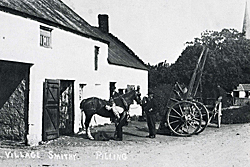
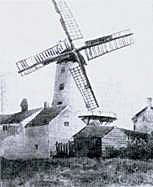 One of the "famous" people of Pilling, according to F.J.Sobee, was a certain
William Thornton. It is claimed that he was presented to King George IV in his
"birthday suit" as a perfect specimen of manhood in the British Army! What kind
of madness is this? I wish I could find another reference to it. King George IV
reigned from 1820 to 1830 & sure enough, there is a candidate suitable, William
baptised in Pilling in 1801, son of John & Jane Thornton. I wonder if that
period in the Royal history is so bizarre, that parading a soldier naked, is way
down the list of interesting facts!
One of the "famous" people of Pilling, according to F.J.Sobee, was a certain
William Thornton. It is claimed that he was presented to King George IV in his
"birthday suit" as a perfect specimen of manhood in the British Army! What kind
of madness is this? I wish I could find another reference to it. King George IV
reigned from 1820 to 1830 & sure enough, there is a candidate suitable, William
baptised in Pilling in 1801, son of John & Jane Thornton. I wonder if that
period in the Royal history is so bizarre, that parading a soldier naked, is way
down the list of interesting facts!
Another feature of Pilling will be it's Windmill. Built in 1808.
Damside mill in Taylors Lane was built to replace a wooden post mill. It was 6
storeys high standing 73 feet with a second storey reefing stage and 4 sets of 6
foot mill stones. It is now a very attractive home in the private hands of Nick
and Catherine Edwards. There have been wind & water mills near this site for
centuries. On a Yates map of 1786, there was another water Mill marked on the South
side of the road. In 1886 it was converted to steam & the sails taken down.
Robert Mather Cookson, one of the last corn millers at Damside, was born at the mill
& was 7 years old when the sails were removed & used as
gate posts at Birks Farm on Eagland Hill, the home of Old Jemmy Jenkinson.
Links to genealogy
